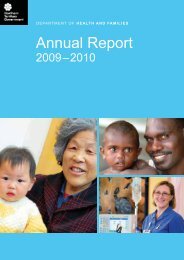PCD Strategy Evaluation 2007.pdf - NT Health Digital Library ...
PCD Strategy Evaluation 2007.pdf - NT Health Digital Library ...
PCD Strategy Evaluation 2007.pdf - NT Health Digital Library ...
You also want an ePaper? Increase the reach of your titles
YUMPU automatically turns print PDFs into web optimized ePapers that Google loves.
The <strong>NT</strong> is leading the way with the establishment of the key performance indicators forAboriginal health, which all services will report on. In addition to this many services participatingin the <strong>Health</strong>y For Life Program will be required to report on progress against key indicators.These indicators should be linked to the priorities and direction outlined in the <strong>PCD</strong>Simplementation plan. It is also important to establish review and monitoring systems at the localservice level as this will assist with strengthening local service provision. Services such as CAACand the Barunga clinic have been applying these principles over a number of years and candemonstrate definite improvements and robust systems as a result of implementing thesepractices.In addition to health outcome indicators it would be useful to report on capacity indicators suchas the vacancy rates and how long positions are vacant as this will also help explain outcomesbeing achieved and if funding for designated chronic disease activity is bitting the target activity.6.3 Best Practice Clinical GuidelinesThe use of clinical guidelines to guide service delivery is integrated as core practice with remotehealth services and Aboriginal Community Controlled Organisations. They use the CARPAguidelines, and general practice use a variety of different guidelines and protocols. In the futurethere is a need for policy direction for urban based <strong>NT</strong>DH&CS staff as to which clinical guidelinesthey should follow for chronic disease care. The scope of practice for urban services is differentto remote services. Therefore the CARPA guidelines are not always appropriate in the urbansetting, nor are they consistent with general practice. Agreeing to a standard set of guidelinesfor urban service delivery will provide the basis for a common language when working inpartnership with general practice and community controlled health services.6.4 Patient information systemsChronic disease care is complex when a large number of patients need to be managed.Therefore the only efficient way to do this is through the use of an electronic patient informationsystem. The lack of an information system in most remote and urban communities is asignificant barrier to high quality care. This was as a major issue that arose as part of thestakeholder interviews.Chapter 6: Discussion – <strong>Evaluation</strong> of the <strong>NT</strong> Preventable Chronic Disease <strong>Strategy</strong> 2007 96
















